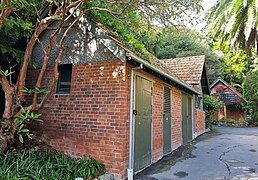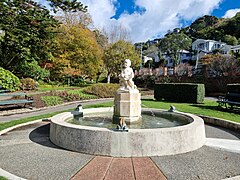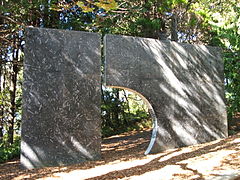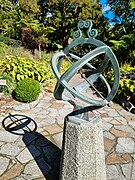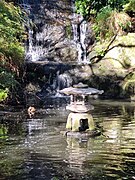Wellington Botanic Garden
| Wellington Botanic Garden | |
|---|---|
 A path in the Wellington Botanic Garden during spring | |
 | |
| Type | Municipal botanical garden |
| Location | Wellington, New Zealand |
| Coordinates | 41°16′58″S 174°45′58″E / 41.2829°S 174.7660°E |
| Area | 61.77 acres (25.00 ha) |
| Created | 1868 |
| Operated by | Wellington City Council |
| Status | Open all year |
| Public transit access | Metlink route 2 Wellington Cable Car |
Wellington Botanic Garden ki Paekākā is a botanical garden close to central Wellington in New Zealand. It covers 25 ha (62 acres) of land in a valley between Thorndon and Kelburn, with Glenmore Street as a boundary along the valley floor. One of the access points is from the top of the Wellington Cable Car. The garden is managed by Wellington City Council, and features protected native forest, conifers, plant collections and seasonal displays and an extensive rose garden. It is classified as a Garden of National Significance by the New Zealand Gardens Trust. In 2004 it was listed as a historic area by Heritage New Zealand. Large sculptures and carvings are located throughout the garden.
History[edit]
Before the garden was established, the area was used by the Ngāti Te Whiti hapū of Te Āti Awa for growing and gathering food for Kumutoto and Pipitea pā. In 1844 the Crown took areas of the Wellington Town Belt, including land for a botanical garden, from the Kumutoto settlement, but returned some of it in 1847. Governor Grey then bought the land in 1852. In 1865 the land was sold to the Wellington Provincial Council for a public park.[1]
The garden was established on a 13 acre site in 1868, extended to 68 acres in 1871.[2]: 122 It was initially managed by the New Zealand Institute (later renamed the Royal Society Te Apārangi) and its manager James Hector until 1891.[3] The garden served three purposes: a trial ground for the government to test the economic potential of various plants, a place for scientists to collect and study native and introduced plants, and a place for the public to enjoy.[2]: 122 The New Zealand Institute planted conifers as part of a programme to import plant species and assess their potential for economic benefit to New Zealand, and these came to form a framework and shelter for other plantings.[2]: 122
Paths were laid out, native plants from other parts of New Zealand planted, and trees and plants labelled, "giving them popular Maori names instead of their scientific appellations [as] it would indeed be a pity not to see the native names of the New Zealand flora perpetuated as long as possible".[4] The first map of the garden in 1875, by John Buchanan, also included a list of all plants growing there, and a survey of native plants indigenous to the reserve.[3] The area that would later become the Soundshell Lawn was levelled in 1880, and Hector established a teaching garden there.[2]: 122
Some animals were kept at the Botanic Garden prior to the formation of Wellington Zoo in Newtown in 1906, including the "City Emu" which died shortly after being relocated to the Zoo from the garden.[5]
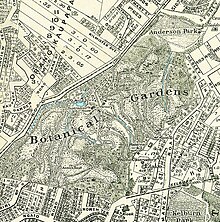
Wellington City Council began managing the garden in 1891, tidying up and developing various parts of the garden to improve public amenity. The garden became more popular with the public after the cable car began running in 1902 and trams started running along Glenmore Street in 1904. The council constructed a tea kiosk at the top of the cable car (1904), a playground near Anderson Park (1905), a rotunda near the duck pond (1907), and a fernery (1911). Public toilets were installed and staff buildings constructed.[2]: 123
Various gullies were filled in and levelled. A gully at what is now Anderson Park was filled in between 1906 and 1910, with later work done between 1931 and 1934 when the park was made larger. The new flat area became Anderson Park sports ground. From 1927, a ridge in the southwest of the garden was flattened and a gully filled in to form Magpie Lawn and Puriri Lawn.[2]: 123
Later developments included the Lady Norwood Rose Garden (1953) which was created over a filled-in gully, Begonia House (1960), a herb garden (1970s), an information centre (1983-1987), the Treehouse education centre (1991) and a sculpture trail (1991).
Live music performances have taken place in the garden since the 1900s, including regular Sunday band performances at the band rotunda built in 1907.[6] Later, a variety of music was performed at the Sound Shell, including pop concerts in the late 1960s and then Summer City events from the 1970s.
In 2019, Taranaki Whānui gifted the name ki Paekākā ("kākā perch") to the garden, and its official name then became 'Wellington Botanic Garden ki Paekākā'. Some Wellington City Councillors raised concerns that the public had not been consulted about the name change.[7]
Features[edit]

The garden contains many discrete collections including the Lady Norwood Rose Garden, rock gardens, cacti and succulents, an Australian garden, camellias, dwarf conifers, a fernery, a herb garden, a grass collection and a fragrant garden.[8] Educational facilities include the Treehouse visitor centre and a discovery garden used for school visits, as well as talks and demonstrations by gardeners on topics such as 'pruning roses'.[9] There are historic wooden and brick buildings formerly used as gardeners' accommodation, workshops and stables.[10] A large playground contains a long slide and flying fox.
Lady Norwood Rose Garden and Begonia House[edit]
The rose garden site was originally a gully with the Waipiro (or Waipirau) stream running through it.[10] The gully was filled in and the current rose garden was then established from 1950 to 1953, in time for that year's royal tour. It is named after Lady Norwood, former mayoress of Wellington, who donated £300 towards a proposed new begonia house in 1949, and in 1955 donated a fountain for the middle of the rose garden. In 1977, the fountain was replaced by a new one donated by Lady Norwood's children. The Begonia House bordering the south side of the rose garden was opened in 1960, after a donation of £20,000 by Sir Charles Norwood, former mayor of Wellington. The Norwood family made further donations for landscaping around the Begonia House and rose garden during the 1970s and 1980s.[11]
The rose garden contains 110 beds of roses, including new and traditional varieties, laid out in concentric circles around the fountain.[12] Climbing roses grow around the colonnades that surround the garden. The flowering season stretches from November to April.[13] The World Federation of Rose Societies awarded the garden a 'Garden of Excellence' award in 2015.[13]
When it was built, the Begonia House was the largest glasshouse in the southern hemisphere.[14]The Begonia House consists of two wings holding tropical and temperate plants including orchids, begonias, cyclamen, ferns and epiphytes, connected by a central atrium. A café was added to the east wing in 1981, and the west wing was extended with a large lily pond with fish and water lilies, added in 1989.[12][14] The Begonia House is a popular venue for weddings and other functions.[15]
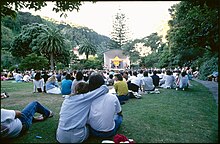
Sound Shell[edit]
The Sound Shell Lawn was originally a teaching garden, then a rose garden. A wooden band rotunda was built in 1907[16] and in use until the concrete Sound Shell was built in 1953. The Wellington Bands Association proposed construction of the Sound Shell as a memorial to bandsmen who had fought and died in World War 1 and 2. A plaque on the structure states: "In commemoration of bandsmen of the Wellington District who served their king and country and of those who also made the supreme sacrifice. 1914-1918. 1939-1945. "Their sound is gone out into all lands" Psalm 19 v4."[17] The Sound Shell and lawn form a sheltered area that has been used many types of event, including band performances, music concerts, Christmas carols, open air dancing, plays, weddings and dance displays.[18] During the summer Gardens Magic season, people picnic on the lawn and trees around the area are lit up.
The Dell[edit]
The Dell is a flat outdoor area of 1,670 m2 (18,000 sq ft) located behind the Begonia House. It is available for hire and has been used for a wide range of events including large picnics, music performances, outdoor theatre and outdoor cinema.[19][20][21][22]
Duck pond[edit]
The duck pond is a naturally-formed pond, fed by the Pukatea and Pipitea streams, and has been a feature of the Botanic Garden since 1868. In times past it was known as the Frog Pond, the Lily Pond and the Swan Pond.[10] In 1996 the pond was enlarged and reshaped, and its surroundings were upgraded with a small pavilion, wetland garden and lookout points.[23] In 1998, landscape architect Stephen Dunn of Boffa Miskell won a silver award for his redesign of the pond, in a competition held by the New Zealand Institute of Landscape Architects and the Landscape Industries Association of New Zealand.[24]

Sculptures[edit]
There are a variety of sculptures in the Botanic Gardens. Near the Founders Entrance are two small statues of a child pouring water from a jar. The original statues were made of cast iron and installed in the garden between 1906 and 1910. After the statues were stolen and returned, replicas were made in bronze for display, while the original iron statues are kept in safe storage.[10] Also near the Founders Entrance is the 'Joy' fountain which consists of a round pool with three frogs spouting water, with a central figure of a child with doves, carved in Hinuera stone. The work was completed in 1946.[10]
In 1975 the Japan Society of New Zealand gifted a carved stone lantern that is now located in the Peace Garden adjacent to the Lady Norwood Rose Garden.[25] In 1994 the lantern was adapted to house the Hiroshima Peace Flame in recognition of Wellington's nuclear free status.
In the 1990s, Wellington Sculpture Trust began a project to place sculptures in the garden.[26][27] The result is the Botanic Garden Walk, a loop walk through the garden that takes in six sculptures including one by Henry Moore.[28]
Treehouse visitor centre[edit]
The Treehouse is a visitor and education centre, shop and administration centre located in the middle of the gardens.[29] The facilities include a seminar room and exhibition area.[30]
Notable trees and plants[edit]
The Botanic Garden contains remnants of lowland broadleaf native forest. These pockets of forest cover eight hectares near Fern Glen Stream, Stable Gully, and the Salamanca hillside south of the Lady Norwood Rose Garden. There are areas of predominantly kānuka, kamahi or kohekohe, but also large hinau and rata trees that have survived since pre-European times. Although these forest remnants have been modifed by human interaction and introduced species and pests, they still have much scientific and heritage value.[31][32]
The New Zealand Tree Register lists noteworthy native and introduced tree specimens in the garden, for example a Pinus pinea planted around 1870 as part of the Botanic Garden's early role in assessing the economic potential of introduced species. The genetic value of trees like this has increased since their decline in their native habitat.[33]
A threatened species garden next to the Treehouse education centre displays native plants that are under threat.[34]
Near the Cable Car Entrance to the garden is a cypress planted in the 1970s which has been pruned into a 'bucket' shape. The tree, nicknamed the 'trippy tree' or 'bucket tree', is known as a hangout for students, who climb into the tree where they can see but not be seen.[35] A 'Top 10 trees' list in 2013 described the tree: "a circular platform formed by branches at the top of the "trippy tree" gives sweeping views of Wellington. Authorities are wary of drunken antics at the site".[36] In 2014 the Draft Management Plan for the Botanic Garden recommended removal of the tree, but in a submission on the plan, the Friends of the Wellington Botanic Garden stated: "We are aware of the difficulties with the ‘bucket tree’ and note its planned removal. It is, however, a garden iconic feature known to many visitors who comment favourably when they see it." In 2022 the tree was fenced off, with a sign stating: "please do not climb me – my branches aren’t as strong as they used to be’".[36]
An unusual plant in the garden is the voodoo lily, which only flowers once every few years and smells like rotting meat. Plants such as this attract a lot of public interest.[37]
Wildlife[edit]
A variety of native birds can be found in the garden.[38] Notable is the kākā, a large native parrot that has become much more common in the garden since the success of a breeding programme at Zealandia.[39] The increased number of kākā has led to serious damage to historic redwood trees and Norfolk pines in the garden, as the birds peel off bark to get to the trees' sap. [40][41] In March 2024, two mature redwoods planted around the 1870s had to be removed from the garden because of decay caused by kākā damage.[42][43]
Glow worms are visible some nights along paths in the main garden near the duck pond, and visitors can take a tour to see them.[12]
Events[edit]
Summer City / Gardens Magic[edit]
As part of its Summer City programme, Wellington City Council organised events in the Botanic Garden during summers from 1979 to the early 2000s, including live Shakespeare, free movies, teddy bears' picnics and free concerts.[6] The concert series continued at the Sound Shell and in 2024 celebrated 44 years of concerts. The series is titled Gardens Magic and also includes a light show.[44][45]
Tulip Sunday[edit]
Tulip Sunday is part of a spring festival held annually in the gardens, usually near the end of September. Visitors enjoy seeing the flower beds near the Founders Entrance filled with masses of tulips in full bloom, and can enjoy entertainment (often Dutch-themed) organised by Wellington City Council and sponsors.[46][47] The date of the event is decided months in advance due to the organisation required, but sometimes the tulips reach full bloom earlier or later than the scheduled date because of the weather.[48] Tulip Sunday in Wellington began in 1944 with between 10,000 and 20,000 tulips on display and music provided by a band.[49][50] The event received a boost in 1948, when the Netherlands government gave 25,000 tulip bulbs to Wellington in recognition of New Zealand's welcome to Dutch refugees after World War 2.[51]
Access[edit]
The main entrance to the Botanic Garden is the Founders Entrance on Glenmore Street, which leads past formal flower beds to the duck pond. As of 2024, a No. 2 public bus stops outside this entrance. The Centennial Entrance near the Founders Entrance provides vehicle and pedestrian access from Glenmore Street to the Lady Norwood Rose Garden, and a path from Bolton Street Cemetery past Anderson Park also leads to the rose garden. Further up Glenmore Street from the Founders Entrance are the Pipitea Entrance and West Entrance, which lead to the Puriri Lawn and Magpie Lawn. Three more pedestrian entrances provide access from the south, at Glen Road, Mariri Road and Boundary Road.[52]
At the top of the hill, the Cable Car Entrance gives access from the top of the cable car route. The Wellington Cable Car runs between the top of the Botanic Garden and Lambton Quay in Wellington's central business district. A wide paved path provides a popular downhill route, taking about 30 minutes to walk from the Cable Car Entrance to the Founders Entrance.[52]
Observatories[edit]
In the south-east part of the Botanic Garden near the cable car station and museum are several observatories. The Carter Observatory (aka Space Place) is owned and managed by Wellington City Council, while the Dominion Observatory, Thomas King Observatory, and MetService building form the Observatory Reserve, owned by the government and managed by the Department of Conservation. Wellington City Council maintains the grounds around these buildings to ensure they are in keeping with the rest of the garden, although they are not officially covered by the Botanic Garden management plan.[2]: 10
Awards and recognition[edit]
Wellington Botanic Garden is classified as five-star (a Garden of National Significance), by the New Zealand Gardens Trust.[53] In 2004 it was listed as a historic area by Heritage New Zealand.[54]
Gallery[edit]
- Wellington Botanic Gardens
-
Part of cacti and succulents garden
-
Historic stables in the garden
-
Part of Main Garden and floral displays
-
The playground, 2024
-
Begonia House
-
Garden view looking toward duck pond and Treehouse
-
Joy Fountain, completed 1946
-
Rudderstone, by Dennis O'Connor
-
Statue at the main entrance
-
Centennial sundial, celebrating 100 years of council management of the garden
-
Peace Lantern near the rose garden
-
Summer event in the Dell in 1979
-
Light show at Gardens Magic
-
Concert, Gardens Magic
References[edit]
- ^ Burge, Jason (23 January 2015). "Wellington Botanical Gardens: An Origin Story". Museums Wellington. Retrieved 25 April 2024.
- ^ a b c d e f g Botanic Gardens of Wellington Management Plan 2014 [Report] (PDF). Wellington City Council. 2014.
- ^ a b Shepherd, Winsome; Cook, Walter (1988). The Botanic Garden, Wellington. A New Zealand History 1840-1987. Wellington: Millwood Press. ISBN 0-908582-79-X.
- ^ "Local and general news: The Botanic Reserve". Wellington Independent. 30 January 1871 – via Papers Past.
- ^ "CURRENT TOPICS". New Zealand Times, Volume XXIX, Issue 6203. 8 May 1907. Retrieved 30 January 2019.
- ^ a b Pietkiewicz, Francesca (24 February 2024). "A history of Gardens Magic, the 154-year-old Wellington concert series". The Spinoff. Retrieved 24 April 2024.
- ^ Fonseka, Dileepa (12 September 2019). "Gift of 'Paekākā' to Wellington Botanic Garden triggers councillor stoush over 'unreasonable' te reo use". www.stuff.co.nz. Retrieved 30 April 2024.
- ^ "Wellington Botanic Garden Collection". Wellington Gardens. 2024. Retrieved 30 April 2024.
- ^ "Rose Pruning Demonstration - Wellington - Eventfinda". www.eventfinda.co.nz. Retrieved 30 April 2024.
- ^ a b c d e Hill, Marguerite (2003). "RECN512: Practicum 2003: Heritage Inventory: Wellington Botanic Garden". Research Archive at Victoria University of Wellington.
- ^ Cook, Walter (10 December 2009). "The Lady Norwood Rose Garden and Begonia House". Australian & Aotearoa New Zealand Environmental History Network. Retrieved 23 April 2024.
- ^ a b c "Wellington Botanic Garden ki Paekākā". Wellington Gardens. Retrieved 23 April 2024.
- ^ a b Hayden (21 February 2010). "Lady Norwood Rose Garden - Wellington". The New Zealand Rose Society. Retrieved 23 April 2024.
- ^ a b "Begonia House". Archives Online. Retrieved 23 April 2024.
- ^ "Begonia House Foyer". Wellington City Council. 8 March 2024. Retrieved 23 April 2024.
- ^ "Under the Greenwood Tree". Evening Post. 25 November 1907 – via Papers Past.
- ^ "Glenmore Street, sound shell". Archives Online. Retrieved 26 April 2024.
- ^ "Begonia Gardens, Sound Shell". Archives Online. Retrieved 26 April 2024.
- ^ "The Dell, Wellington Botanic Garden – venue for hire". Wellington City Council. 27 October 2023. Retrieved 3 May 2024.
- ^ Pietkiewicz, Francesca (24 February 2024). "A history of Gardens Magic, the 154-year-old Wellington concert series". The Spinoff. Retrieved 3 May 2024.
- ^ Catherall, Sarah (12 February 2023). "An evening in the Dell with Shakespeare's The Tempest". Stuff. Retrieved 3 May 2024.
- ^ "Botanic gardens film postponed due to wind". Stuff. 19 January 2012. Retrieved 3 May 2024.
- ^ "Pond upgrade". Evening Post. 27 March 1996. ProQuest 314437287.
- ^ "Feather in cap for duckpond's creator". Evening Post. 31 March 1998. ProQuest 314538481.
- ^ "The story behind Wellington's Peace Flame". Stuff. 16 November 2013. Retrieved 26 March 2023.
- ^ "Sculpture unveiled". Dominion. 15 December 1997. ProQuest 314917211.
- ^ Houlahan, Mike (24 June 1996). "Arty steps punctuate garden sculpture walk". Evening Post. ProQuest 314476460.
- ^ "Botanic Garden Walk". www.sculpture.org.nz. Retrieved 28 April 2024.
- ^ "Wellington Botanic Gardens - Tree House Visitor Centre". Citizens Advice Bureau. 19 October 2023. Retrieved 3 May 2024.
- ^ "Treehouse Seminar Room, Wellington Botanic Garden". Wellington City Council. Retrieved 3 May 2024.
- ^ Myers, Shona C (1987). "Native forest remnants in Wellington's botanic gardens". Wellington Botanical Society. 43: 32–40 – via New Zealand Regional Botanical Society Journals.
- ^ Mitcalfe, B. J.; Horne, J. C. (May 2003). A Botanical Survey of the Indigenous Forest Remnants in Wellington Botanic Garden, Glenmore Street, Wellington [Report] (PDF) (Revised March 2005 ed.). Wellington, New Zealand: Friends of The Wellington Botanic Garden Incorporated.
- ^ "The New Zealand Tree Register". register.notabletrees.org.nz. Retrieved 2 May 2024.
- ^ "Wellington Botanic Garden ki Paekākā". Wellington Gardens. Retrieved 2 May 2024.
- ^ Lopez, India (18 March 2010). "Alcohol ban may fell popular hangout". Stuff. Retrieved 2 May 2024.
- ^ a b Manaaki Whenua-Landcare Research (30 March 2023). "Wellington Urban Tree Walk: 29: No more party with a view - the Bucket Tree". ArcGIS StoryMaps. Retrieved 2 May 2024.
- ^ Green, Kate (21 October 2020). "Wellington's stinkiest flower, the Voodoo Lily, back in bloom at the Botanic Gardens". Stuff. Retrieved 2 May 2024.
- ^ "Wellington Gardens Bird Watcher's Guide" (PDF).
- ^ "Kākā". www.visitzealandia.com. Retrieved 30 April 2024.
- ^ "Botanic Gardens' redwoods no match for kākā". NZ Herald. 30 April 2024. Retrieved 30 April 2024.
- ^ Dawson, Bee (4 May 2023). "Experts think they know why native kākā were attacking trees in Wellington". Stuff. Retrieved 30 April 2024.
- ^ Boyack, Nicholas (8 March 2024). "Kākā take on exotic trees, and win". The Post. Retrieved 3 May 2024.
- ^ "The New Zealand Tree Register". register.notabletrees.org.nz. Retrieved 3 May 2024.
- ^ "Gardens Magic ready to hit all the right notes in 2024". Wellington City Council. 13 December 2023. Retrieved 2 February 2024.
- ^ "Wellington.Scoop » Gardens Magic (free!) back for its 44th year". Retrieved 2 February 2024.
- ^ "Tulip Sunday – Dutch Club Wellington". Retrieved 24 April 2024.
- ^ "Te Wā o te Kōanga - Spring Festival". Wellington Gardens. Retrieved 24 April 2024.
- ^ "Wellington's tulips blooming early". Stuff. 18 September 2012. Retrieved 24 April 2024.
- ^ "Tulip Sunday". Dominion. 12 October 1944 – via Papers Past.
- ^ "Tulip Sunday at gardens". Evening Post. 16 October 1944 – via Papers Past.
- ^ O'Neil, Andrea (13 September 2015). "Wellington's Tulip Sunday a reminder of Dutch war horrors - 150 years of news". Stuff. Retrieved 24 April 2024.
- ^ a b "Wellington Botanic Garden ki Paekākā Map [Pamphlet]" (PDF). Wellington Gardens. Retrieved 24 April 2024.
- ^ "New Zealand Gardens Trust - Wellington Botanic Garden". New Zealand Gardens Trust. Retrieved 3 May 2024.
- ^ "Wellington Botanic Garden". New Zealand Heritage List/Rārangi Kōrero. Heritage New Zealand.


